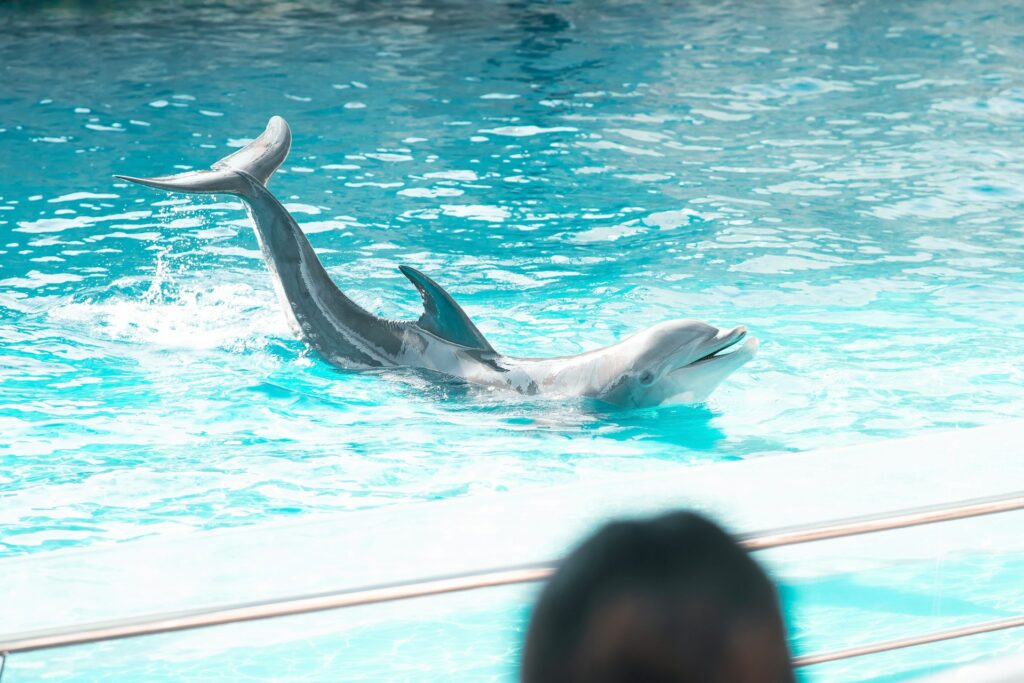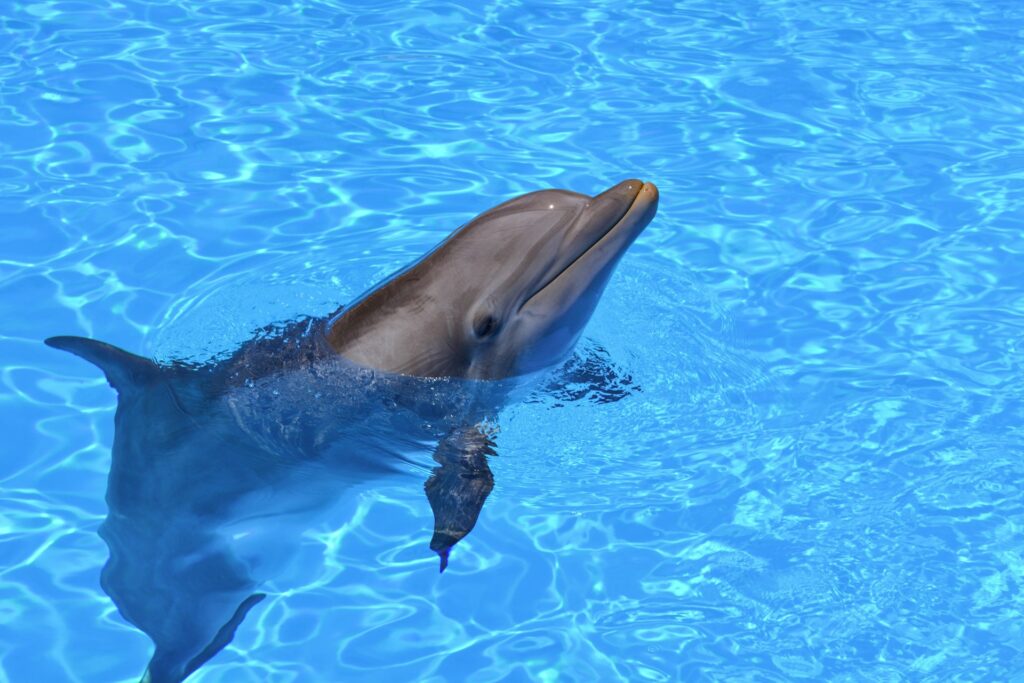Learn about What Happens When Dolphins Are Kept in Pools. Discover the truth about dolphin behavior in captivity, stress signs, and ethical alternatives to traditional dolphin enclosures.
Introduction to Dolphins
Evolution and Classification
Dolphins are cetaceans, and they are members of the Cetacea order as well as the Delphinidae family that contains approximately 90 species of whales, dolphins, and porpoises. They grew out of terrestrial mammals more than 50 million years ago, and they adapted to water life because of great evolutionary adaptations.
Physical Characteristics
The recognizable features of dolphins are the sleek shapes of their bodies that are shaped like a torpedo, their long snouts, and curvy dorsal fins. They differ in size according to species- the 5-foot-long Maui dolphin to the 30-foot-long orca (also called killer whale, yet this is the largest dolphin species).

Types of dolphins
1. Bottlenose Dolphin
Bottlenose dolphins are one of the most popular sea mammals that can be hardly mistaken with their curved mouth and jovial looks. They are creative, very sociable and frequent visitors of aquariums, however, they are best in wild nature, where they can rove freely.
2. Atlantic Spotted Dolphin
Atlantic spotted dolphins possess slick body and unusual spots that grow with age. They live in a warm Atlantic water, are playful and nimble, jumping along or riding the waves. They are interesting ocean animals because of their complicated social life.
3. Common Dolphin
Common dolphins are very quick fishermen, and they have an hourglass-like pattern on the sides. They are social animals and usually move in big groups. It is common to find these dolphins jump out of the water and surf across the bow waves of ships.
4. Risso’s Dolphin
Risso’s dolphins are blunt-headed dolphins with numerous scars due to living and hunting social activities or squids. They can be found in deep offshore and are not very acrobatic as compared to the other dolphins, but they are noted to have strong ties in pods.
5. Spinner Dolphin
Spinner dolphins are also known for their spinning jumps out of the water. They are small and slender, inhabiting the tropical waters and spending the day in the bays, and are more active at night as they hunt. They are quite gregarious and excessively talkative.
6. Pilot Whale
The pilot whales are large dolphins that, despite the name, strongly bond together in groups. They are found in the deep waters of the ocean and feed primarily on squid. These dolphins are passionate and tend to stay in groups, an aspect symbolizing their strong attachment to their pod.
Do Dolphins Enjoy Swimming in Pools?
Dolphins are social and intelligent animals which live along the open ocean. They can swim in the pools but it is not that good as far as mental and physical health is concerned. Dolphins do not receive space, stimulation, and the natural environment in the pools. Thus, they can swim in pools but do not love it.
Dolphin Intelligence and Communication
Echolocation Explained
Echolocation, which is a biological sonar system, is one of the most interesting features of dolphin intelligence. Even in turbid water, dolphins produce high-frequency clicks and intelligently use the reflection that takes place when the click hits the object to move around and hunt.
Social Behavior and Pods
Dolphins are very socially oriented animals, and they usually move in a group referred to as a pod that may consist of a few or even hundreds of dolphins. They develop lifelong associations, and they do joint hunting and even give each other special names, like whistles, in the name of the others.
Habitat and Natural Environment of Dolphins
1. Oceanic Dolphins vs. River Dolphins
Majority of the dolphins live in saltwater, but there are certain species such as Amazon river dolphin which fare well in fresh water. Generally, oceanic dolphins are located in the global waters and found in coastal as well as offshore ones.
2. Preferred Water Conditions
The dolphins love warm and temperate water and tend to migrate according to the availability of food. The wilderness provides them with a lot of space, intricate ecosystems, and constantly evolving stimuli, which are imperative in their mental and physical well-being.
Diet and Feeding Habits
1. Hunting Techniques
One of the dolphin hunting methods involves corralling, where dolphin groups can collaborate to push fish towards small areas and strand feeding, when dolphin temporarily beaches to capture food.
2. Types of Prey
Fish, squid, and crustaceans form a large part of what they eat. Species and locations vary the exact composition, but dolphins are classified as opportunistic feeders, frequently adapting to possible food availability.
How Captivity Affects Dolphin Behavior
1. Physical Impacts
Dorsal fin collapse is a condition that is usually not seen in nature on captive dolphins. Their muscles could also be undeveloped as they are restricted in the areas of swimming.
2. Psychological Impacts
Being in captivity may result in boredom, depression, and anxiety. Most of the dolphins in pools develop unnatural behaviors or show a lack of responsiveness after some time.
3. Case Studies and Observations
They have found more stress hormones and reduced lifespan in captive dolphins than in wild dolphins.
How Dolphins Use the Ocean for Mental & Physical Health
1. Dolphin Intelligence and Behavior
Dolphins have a very developed intellect, showing problem-solving, emotional intelligence, and social bonding. Their playfulness and curiosity prove that they have a very complex mental life, rendering them highly susceptible to unnatural and constraining environments such as pools.
2. Natural Habitat of Dolphins
In the wild, dolphins swim for long distances, every day socialize with big pods, and enjoy varied ocean environments. This kind of natural habitat provides continuous mental and physical stimulation, but fails in captivity and thus has a significant impact on well-being.
3. How Dolphins Use the Ocean
The ocean offers these dolphins the opportunity to echolocate, hunt, socialize, and explore. All these keep them physically fit and mentally stimulated, as they provide freedom that pools can never achieve, even under ideal conditions.
4. Dolphins in Captivity
In captivity, dolphins lose access to their vast natural environment. Confinement restricts natural movements and behaviors and can lead to boredom, frustration, and stress-related illnesses that would not typically occur in dolphins’ natural ocean environments.

What Happens When Dolphins Are Kept in Pools?
Water Quality and Chemical Concerns
Although it is maintained clean for human viewing, chlorinated water might irritate dolphins’ eyes and skin. This also dilutes the richness of the ocean, which has natural healing minerals.
Noise Pollution in Captive Pools
The constant hum of filtration systems, construction noise, and crowd chatter drives one insane. Sensitive hearing dolphins can become starved or withdrawn.
Alternatives to Captive Pools for Dolphins
Sea Sanctuaries
Dolphins get a protected ocean environment, which is more like their natural habitat. They are not contained in pools; they are free to enjoy broad open places, be stimulated by nature, and interact with others. That means better mental and physical well-being while maintaining a safer, non-captive existence.
Open Water Rehabilitation Programs
Open-water rehab programs help prepare dolphins held captive or injured to adjust back to natural environments. Gradually rebuilding their hunting, navigation, and social skills so that release into the wild could eventually be an option for those who can’t survive in their environment for full-time captivity or semi-natural settings.
Conclusion
There is evidence that dolphins in pools face stress, restricted space, and unnatural conditions. True well-being can only happen in the ocean. It is time we ethically put the importance of their habitat over the pleasure or convenience of mankind.
